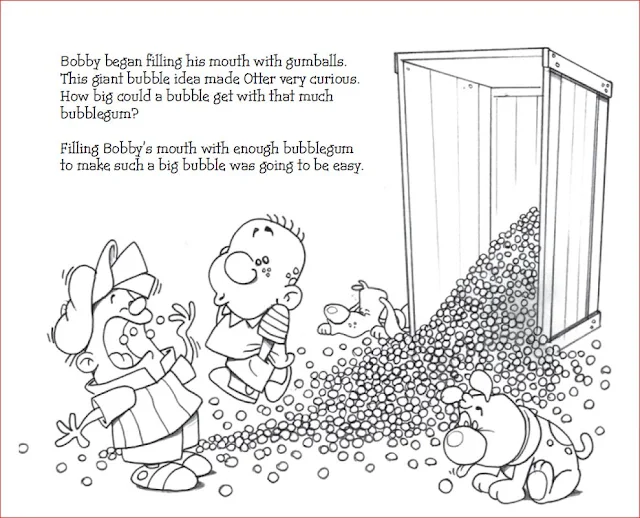Part 3: The BIG problematic finale!
I take back what I said before. This part is the most significant change to the story -- where my climatic ending just wasn't that exciting! (Lots of standing around.)
SPOILER ALERT: I'm about to give away the end, so here goes . . .
Image #10: We left off where the boys lost the giant bubble to the wind while on the park's highest hill.
I knew my ending already: the giant bubble deflects a meteor that was heading to the center of the town. I was stuck on how to get to that point. So I wrote the following:
1.) The bubble floats away with the wind. (Ok, that's how the bubble collides with the meteor.)
2.) The boys run after it, leading them to the center of town. (Ok, that gets them to the location)
3.) My story's BIG problem: how to suddenly mention that a meteor was heading toward the town.
I worked around this problem by having the town already know the meteor was coming and that officer Augie (later named Mike) was evacuating the area. I was not happy with this idea.
 |
Image #10: Those who have read the book may notice this is now Mrs. Applebottom's location.
Note the newspaper headline . . . |
Image #11: I had to take a page or two to explain the dire situation. So I had Officer Augie explain to the boys about the danger approaching the town. I didn't realize it back then, but I was creating a situation in the story that could potentially scare children who were reading the book. I didn't want the story to focus so much on the meteor and the danger. I didn't want children thinking their town too could be hit with meteors.
When doing the 3rd rewrite, the idea of losing the bubble to the wind and the evacuated town was utterly tossed aside.
 |
| Image #11: Officer Augie is taking WAY too much time telling the boys they are about to get hit by a meteor. |
Image #12: This is such a poor perspective and such a mediocre attempt at creating tension to the story. I started to notice what was missing -- and that was Bobby's biggest bubble. The main focus was nowhere to be seen. To follow just the characters without even seeing the bubble for many pages, was a poor decision.
When doing picture books, it's vital that the images alone can tell the story. If I took the words away from these several pages -- no one would know what was happening, including me.
 |
Image #12: Oh No! Guess who wasted too much time hanging around a danger zone area?
(And where did Officer Augie's newspaper go? Where'd that squirrel come from?) |
Image #13: This was just a silly filler page I added, but later I used this as a promotional idea.
I took the gum-wrapper artwork and made mock versions using packs of Trident and Dentyne gum. I would send a pack of gum wrapped with the Bobby gum-wrapper to publishers, along with a query letter and dummy book. (See my past blog about this by clicking HERE.)

To the people who have read the story, you can see the big changes that were made to Bobby Biggest Bubble. The re-writes helped me iron out the weaker areas and helped me revision the story in a far better way than I originally imagined.
Now the bubble appears on almost every page (in one form or another!) While it still has the meteor ending, it feels more humorous now than the original doom and gloom of the original. Bobby and Otter are visually the best of friends from the start. Overall, there a pattern and flow to the story.
Every story I do from now on will be re-written many times for this simple reason; every re-write tends to bring new and better ideas. Every re-write helps eliminate errors and weaknesses.I'm very proud of how the story turned out and heard many comments from parents who say their children enjoy the book ( -- and THAT is the importance of the re-write.)



































